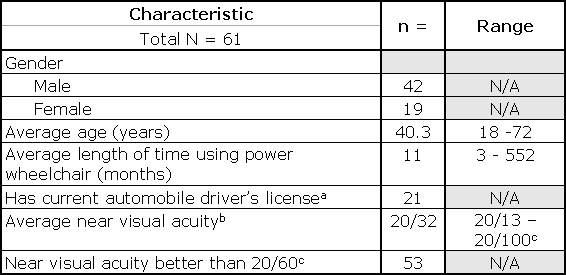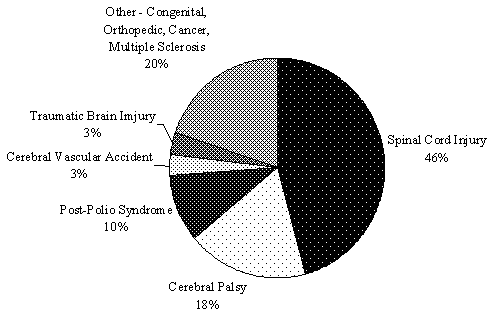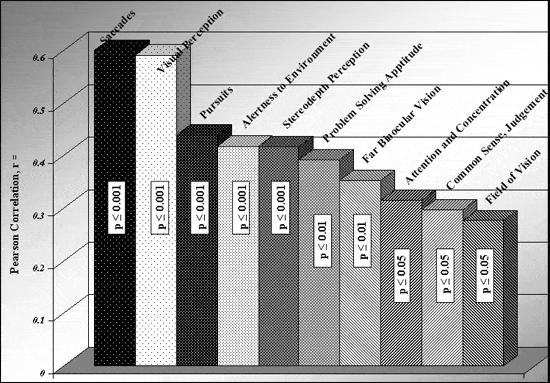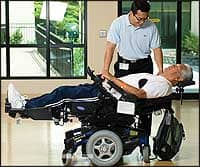 |
| Abdon Angeles, PT, standing, helps Richard Flores learn the functions of a state-of-the-art wheelchair. Flores is a patient at Casa Colina Centers for Rehabilitation, in Pomona, Calif. |
Roam through the parking lot of any “big box” chain store and observe the impressively large number of spaces reserved for cars with handicap license plates. Notice too that during peak hours on any given shopping day, most or all of those spaces are filled.
“The fact is that paraplegics, quadriplegics, and others with physical impairments and health-related issues are simply more mobile than ever, thanks to the many mobility solutions that now exist for them,” says Calvin Cole, vice president of Hoveround, a Sarasota, Fla-based scooter manufacturer that last year sold nearly $100 million worth of product and that expects soon to be in the $250 million ballpark. “People are putting wheelchairs and scooters of all types on and in their cars, trucks, and vans. Some people are driving the mobility device itself in place of a car, using it for travel of as much as five miles a day in some instances.”
The proliferation of mobility devices reflects not only growth in the population of people with disabilities, but also the increasing desire among those with ambulatory impairments to access their environment with greater ease and efficiency. “That’s driven a lot of new features on mobility products in recent years,” says Chris Clutter, PT, NSC, a Level III therapist specializing in spinal cord injury cases at St. Luke’s Rehabilitation Institute in Spokane, Wash.
Innovation Rolling Along
Among manual wheelchairs these days, what everyone seems to want most is good push-mechanics. Says Clutter, “We need the axle to be in an optimum position and the frame to be as lightweight as possible so that the user can get around with less effort—the better the push-mechanics of the chair, the less repetitive strain injuries we’re going to see.”
Gaining in popularity as well are standing wheelchairs and seat elevators, both of which are meant (at least in part) to reduce or altogether prevent overhead strain injuries. “Seat elevators were kind of a novelty until fairly recently,” says Clutter. “Five years ago, we saw them on maybe one chair; now, almost every manufacturer offers them. They rise anywhere from 8 to 15 inches or more above their normal position, which allows the user to directly access things on shelves and in higher cupboards, which would ordinarily be out of reach. As therapists, we think this is an excellent innovation because it cuts down on the need for the wheelchair user to reach overhead for items—and that means fewer shoulder injuries.”
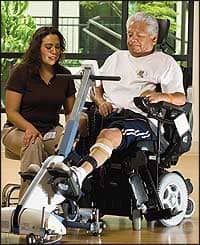 |
| Physical therapist Laura Batres, left, oversees patient Richard Flores’ therapy on a recumbent electrical simulator. |
Power mobility devices (PMDs) likewise keep getting better. Computerization, for instance, is becoming more and more prevalent among PMDs. This September, Invacare—a leading maker of many different mobility products—plans to roll out a new PMD electronics package, the Mark VI-i. “On the consumer side, we’ve focused on ease of use with several redesigned joysticks and bigger display graphics,” says Mark Sullivan, vice president of the rehab category for Invacare in Elyria, Ohio. “We’re offering ‘smart technology’ that allows the consumer with the flip of a switch to tilt and recline the chair to preset favorite positions. It’s a feature that will increase comfort and permit easier execution of frequently performed tasks, such as getting in and out of a vehicle.
“For the clinician, the Mark VI-i incorporates new language and special help keys for easier programming. For the rehab provider, it has improved diagnostic capabilities and accepts a removable data storage card that can contain hundreds of different, downloadable programs—or that can capture data from the chair itself.”
At Quantum Rehab, a division of Pride Mobility, Exeter, Pa, a new line of electronics will be introduced this fall, says Cody Verrett, ATS, director of clinical and educational development. Q-Logic, designed for disabled users who require power mobility, has many consumer-based features incorporated into the product.
“Some of these features include a speedometer, a trip and distance odometer, remaining battery level in a percentage value calculated in real time, as well as an option for a consumer to showcase personal photos on the color display,” he says. “Along with these unique features, we addressed many of the advanced programming capabilities sought and required by top providers and clinicians for switch and secondary control input devices.”
Elsewhere around the industry, computer-based enhancements are leaning toward controls operated by voice command. “That’s the next coming thing,” says Clutter. “Voice control will eliminate the need to load the system with space-consuming head, hand, body, or breath-activated function switches. Voice systems will also be tied into wireless transmitters that allow the user to speak a command in order to turn on lights and televisions or answer the phone and operate other equipment in their environment.”
According to Rick Michael, vice president of Innovation in Motion, Angola, Ind, the 7-year-old company has taken the industry changes and rolled with them.
“Bringing our pricing more in line and our discounts in line with the industry standards, and being able to offer a better variety of options that the consumers need and request,” he says, are some of the recent changes the company has been undertaking. “As the years have gone by, we’ve begun to offer more options, more colors, more seat sizes. We’ve developed our first generation of Extreme [power wheelchairs]. Instead of a 265-pound weight capacity, we very quickly realized that here in the United States we needed to expand it, so we came out with the second generation with a 400-pound weight capacity. We just tweak it as the industry requires and we move with it.”
Code Language
Manufacturers of mobility products can make their offerings lighter, stronger, sleeker, more maneuverable, and accessories-laden (all of which they are doing) to satisfy the wishes of users and clinicians, but what they cannot seem to make is a better way to move payors from Point A to Point B concerning improvements in the adequacy of funding.
“An issue we continue to face is that our industry is more art than science, and that makes it difficult for the reimbursement world to value the services being provided,” says Tom Whelan, global vice president for seating and pediatrics at mobility products giant Sunrise Medical in Longmont, Colo.
The good news is that rehab practices, clinics, and hospitals may shortly see some relief: beginning October 1, potentially helpful changes in Medicare coding of PMDs are slated to take effect. According to Clutter, the 61 specific and three miscellaneous new codes should give physicians and other practitioners more latitude when it comes to matching up patients with the most appropriate chair while, at the same time, reducing incidents of downcoding and claims denial.
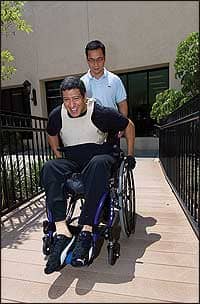 |
| Patient Boris Delcid, seated, is guided down a ramp at Casa Colina’s wheelchair training area by physical therapist Abdon Angeles. |
“We have been championing the cause in Washington, DC, to ensure that the products that we create are well positioned and are still a tremendous value to our providers, but also have the quality levels that are deemed necessary by the new codes,” Verrett says. “We’ve been on top of the code changes and the impending revision of Medicare’s allowables and the way they pay for power mobility for a number of years, and working really closely with it for the last 2 years specifically to prepare for them. We feel like we are ahead of the game and well positioned to have a lot of products that meet a lot of the different codes.”
“Changes in Medicare funding are reshaping the market, and Convaid is rising to meet the challenge of producing products with extensive growth potential and advanced seating for all-day use,” says Nathan Watkins, vice president of Convaid Inc, Palos Verdes, Calif.
Because of the Medicare changes, TiLite, Kennewick, Wash, has adjusted the way it markets its chairs across the board. Josh Anderson, vice president of marketing, says the company has redirected its marketing focus from telling consumers and therapists about the benefits of better quality materials and CAD design for total chair customization, to focusing on dealer/providers and funding sources.
“We have done this in several ways, most notably with the addition of a funding section on our Web site,” he says. “There, you can read independent research summaries discussing the benefits of titanium, weight, performance, durability, and customization. This information has helped dealers explain the benefits of TiLite chairs to funding sources to help them understand why these chairs are a necessity, not a luxury.”
More Standardization
Although more Medicare beneficiaries will likely be able to obtain the PMD they really need thanks to the new codes, many others who could benefit from such equipment are almost sure to continue being denied sufficient funding, and for all the familiar reasons. PMDs will thus remain beyond their grasp. As such, “balancing the needs of the consumer with the realities of reimbursement will clearly be the number one issue” facing the industry, Whelan contends.
In response to this challenge, Whelan says his company is striving to make ever-more advanced product but at lower costs in order to narrow (or at least forestall any further widening of) the gap between retail price and payor reimbursement. Sunrise Medical hopes to achieve this by “modernizing our approach to maximize efficiencies, which may also include utilizing vendors outside of the United States,” he says. “[We believe] manufacturing will have to continue to carve out efficiencies in processes, locations, and footprint size.”
Over at Hoveround, part of the response to the reimbursement challenge is to push for greater standardization of products—in the modularity and interchangeability of the components that go into their manufacture. Not only does this help lower production costs, it also sets the stage for more economical servicing, Cole explains.
“In all the talk about product innovation, the thing that tends to be overlooked is the service component—and service is an area where we can help really drive costs out of the system,” he says. “For example, in the past, you’d have a school where 35 kids are in 35 different powered wheelchairs, with different power bases and positioning systems. From the service aspect, that makes things very challenging, not to mention costly. Because if five of those chairs break in the same week, the service tech has to contact five different manufacturers so he can try to figure out the diagnosis for each one and whether parts for the older chairs are still available or if there is any cross-compatibility to them. This is a situation we’re trying to remedy.”
There are, of course, other ingredients that go into satisfying a mobility product user these days—aesthetic appeal and application versatility chief among them. Yet, no matter how the satisfaction angle is broached, it is evident that users of mobility products are by and large delighted with their equipment. That is not to suggest they wouldn’t in a heartbeat be willing to step up to something snazzier or more maneuverable or more responsive—in fact, most surely would. Rather, the source of their delight is the unprecedented freedom to come and go as they please, a freedom made possible by the remarkable array of mobility products offered today—one for almost every need.
A Variety of Mobility
If manufacturers were to be graded on their innovativeness, Clutter would hand some of them a report card filled with straight As.
“The companies I’m familiar with are cutting-edge when it comes to technology innovation,” Clutter says. “I’d also give some of them an A for their efforts to educate therapists with regard to those technologic innovations. For example, a couple of the major manufacturers come around to us here at the hospital once a year to introduce their new products, and they send our therapists to training courses to learn how to work on and program their powered wheelchairs. They do a really good job of explaining the pros and cons of their products and in giving solid reasons why they’ve come out with this or that new feature. They also have therapists working at the development level to help them trial the chairs with various users to obtain feedback that then becomes the basis for further refinements.”
Here is a brief and by no means comprehensive sampling of some of the advances being made by manufacturers of various types of mobility systems:
- Performance wheelchairs. TiLite has recently added the TX, a folding manual chair that was developed with a little help from techniques known as “rapid prototyping” and “finite element analysis.” What those basically boil down to is exhaustive scientific analysis of customer needs and then designing the product to optimally satisfy them. The TX is stronger, lighter, and smoother riding than comparable products, and incorporates a new cross-brace configuration that works in conjunction with the chair’s welded one-piece side frames and fully integrated caster housings to permit better energy transfer for more efficient propulsion.
Also new from TiLite is its Aero Z ultra-lightweight aluminum chair, which borrows key technologic elements from the company’s titanium line of chairs to remarkable effect. The Aero Z is fully custom-made, offering a range of seat widths and center-of-gravity choices for maximum fit and performance characteristics.
Meanwhile, on the opposite side of the country, in Exeter, Pa, Quantum Rehab early this year unveiled the latest addition to its groundbreaking Q6 Power Chair series, the Quantum 600 with XL Package. This heavy-duty rehab power chair boasts a carrying capacity of 400 pounds and can make speeds of up to 4.5 mph thanks to the powerful new GLIDE motors. Its performance prowess derives in part too from Quantum Rehab’s patent-pending Mid-Wheel 6 design platform in combination with its (likewise patent-pending) Active-Trac® ATX Suspension system.
- Bariatric wheelchairs. Ellis, Kan-based Wheelchairs of Kansas offers the Overlander PEV 2000, a powered chair with a 750-pound carrying capacity and extrawide, extradeep seating. Built around a heavy-duty steel frame, this custom-made power wheelchair comes with super-strong PEV footrests (an optional version features an elevating capability), large footplates, and heel loops. Also included are rugged, four-ply tires (the rear axle is made of 3/4-inch hardened steel), adjustable suspension, and a pair of four-pole motors; coupled with its nonslip gear belt drive, the chair is capable of performing as an all-terrain device.
Long-term comfort is often what the user requires above all else; in that event, the Model 650-H Hoss power wheelchair from ConvaQuip Industries Inc of Abilene, Tex, could be the ideal fit. The 650-H is available with an orthopedic-contoured captain’s chair with user-adjustable width, depth, height, and angle. Its 27-inch turning radius is among the shortest around, making the chair superbly maneuverable indoors. It runs on a heavy-duty, four-pole, 80-amp motor—that’s power enough to travel up a 9-degree slope carrying a 650-pound rider.
- Pediatric wheelchairs. A.R.T. Group, a division of Sunrise Medical, offers its new Mighty Lite wheelchair line. This agile, lightweight pediatric transportation chair is capable of handling complex positioning and mobility needs for short distances and milder positioning needs for longer trips. The Mighty Lite package includes an “H”-type harness trunk positioning belt and padded covers. Among its key features are multiple seat angles, 10-inch rear wheels (standard), snap-button seat-depth adjustment (providing 2 inches of built-in seat-depth flexibility), adjustable back angles (85E, 90E, and 95E), positioning accessories (adjustable lateral Scoli strap, foam wedge, padded head-wings, and full torso support vest), height- and size-adjustable headrest collars, and other accessories (such as a canopy and utility bag).
- Scooters. Introduced last year was the Celebrity X, the next generation in luxury scooters from Pride Mobility Products Corp of Exeter, Pa. Offering a sporty new look, the feature-rich Celebrity X is available in either a three- or four-wheeled format and comes with a wraparound-handle Delta tiller (for ease of throttle operation), automatic latching lock-up mechanism (for faster assembly and disassembly of its seven component pieces), and long-lasting LED bright lights (for enhanced operator safety outdoors). Able to carry a person weighing 350 pounds, the Celebrity X takes the checkered flag with a top speed of 6 mph.
Rich Smith is a contributing writer for Rehab Management.
AN INDEPENDENT VOICE |
|
By Morgan Saffari Mobility devices give physically impaired individuals a relative degree of freedom. But what about those individuals who seek independence through mobility and communication? In 1983, one of the cofounders of DynaVox Technologies, Pittsburgh, a provider of augmentative and alternative communication (AAC) solutions, was an electrical engineering student at Carnegie-Mellon University. He volunteered at what is now called the Children’s Institute in Pittsburgh, says Joanne Kaufmann, public relations supervisor for DynaVox. It was there he met a young woman with cerebral palsy (CP). She had no cognitive deficits, but was unable to communicate because the athetoid CP dramatically limited her motion. The result of this encounter, a device invented by him and one of his professors, was the EyeTyper system. It enabled her to look at targets on a board, select a letter by tracking her movements, and send that letter to a message window. Because of the tremendous amount of head control, and because a user had to be literate to use the product, the company came up with a symbol-based solution. It still was not quite what they had envisioned, and the company spent almost the next decade working on a better, faster, more useful solution. In 1991, that product came to fruition, Kaufmann says, and became the flagship product—the original DynaVox. “It was the predecessor to what we offer today,” she says. “It was a dynamic display. It was limitless, virtually. And not just in terms of how you put information in and how information came out, but how you accessed it. You didn’t have to have that head control. If the only thing you could control was your finger, you could plug a switch into it and hit it with your finger. You could use eye gaze. You could use head pointers. It was limited only by the team you were working with and how they could find the best access method for you.” “We invest a lot of money in research and development, always looking for new ways to enable our users to communicate more efficiently, more effectively to create this meaningful connection with their environment,” says Jim Shea, vice president of marketing for DynaVox. What DynaVox did was give communication back to the individual, or augmented communicator, by allowing them to interact with others in a traditional, mainstream setting, Shea says. “From a socialization standpoint, these products allow augmented communicators to engage more with social interactions, greater social opportunities,” he says. Through AAC technology, employment opportunities in a sheltered work environment were now available to these individuals. Additionally, users who acquired a disability in adulthood could continue their employment without interruption or remain in the workforce longer than they otherwise would have been able to, he says. On the other hand, this technology allowed these individuals for the first time to clearly communicate their needs and desires with their caregivers. “Often we hear from the people who care for them that these products have changed their perception even about the individual,” Shea says. “For the first time, they are able to see the person as opposed to the disability.” According to Shea, all of DynaVox’s speech output devices are covered by Medicare, Medicaid, and private health insurers, so the task of finding the money for such a product isn’t as daunting as some may think. Additionally, DynaVox has the AAC industry’s largest funding department dedicated to assisting its clients throughout the funding process. “Each state actually has different requirements, each health insurance company has different requirements, in terms of the reports or the materials/documentation needed, evidence and assessments needed, and so our funding coordinators actually partner with our customers to ensure that the funding is secured the first time it’s requested,” Shea says. “We do have knowledge of the top insurance companies and their requirements as well as knowledge of each of the states.” Morgan Saffari is the associate editor of Rehab Management. |
MEASURING DRIVING PROFICIENCY FOR POWER CHAIRS |
|||||||
|
By Samantha Massengale, OTR/L It is estimated that at least 750,000 people in the United States use powered mobility as a means for independence.1 The power wheelchair can significantly help improve quality of life by allowing independent mobility in home and community settings.2,3 The increasing prevalence of chronic disease and the changing demographics of our society have resulted in a dramatic growth in use of powered mobility.4 This growth is also due to changing attitudes toward individuals with limited mobility, increasing knowledge of consumers and their advocates, and technological advancements in power wheelchair design.5 Consequent to the increased use of powered mobility, as well as wheelchair accidents,6 the demand for rehabilitation providers to determine safe driving proficiency and/or to identify the driving skills needed to attain safe proficiency has increased.1 An exhaustive literature research has revealed a lack of objective, comprehensive assessment batteries to provide clinicians with guidelines when evaluating for driving proficiency and safety in power wheelchair use.4 Although a number of nonstandardized checklists are available, they do not meet the established requirements for a scientifically sound measurement tool.4 The current body of knowledge is lacking with respect to objectively defining factors such as vision, cognition, visual perception, and psychological functioning and their impact on power wheelchair driving ability. Therefore, the purpose of the study conducted by the Vocational Rehabilitation Unit Therapy Department at Roosevelt Warm Springs Institute for Rehabilitation in Warm Springs, Ga, was to gather objective data concerning the extent to which visual function, visual perception, personality traits, and cognitive skills impact power wheelchair use. It also hoped to provide baseline information to help clinicians determine or predict driving proficiency and/or develop service plans aimed at addressing those skills that need improvement or compensation to ensure driving proficiency. DRIVING EXPERIENCE AND VISUAL FUNCTIONSixty-one adult power wheelchair users, with a minimum of 3 months of driving experience, were recruited for this study. (Refer to Table 1 below for participants’ demographic information.) Each participant’s visual function, including visual acuity, ocular motor functions (saccades and pursuits), stereodepth, binocularity, and color perception; visual perceptual skills (measured by the Motor-Free Visual Perception Test Revised or MVPT-R); and cognitive skills (abstract reasoning, problem solving, aptitude, and intelligence—measured by the Test of Nonverbal Intelligence) were evaluated using a battery of standardized tests. In addition, attention, concentration, and immediate auditory recall (measured by the Digit Span, subtest of the Wechsler Adult Intelligence Scale Revised or WAIS-R) and common sense, judgment, and reasoning skills (measured by the comprehension subtest of the WAIS-R) were observed, as well as the personality trait of conscientiousness (measured by NEO Five-Factor Inventory).
The Power Mobility Road Test (PMRT) developed by the investigators (PT/OT) was used to measure power wheelchair driving performance (see Figure 1 below). The results showed that power wheelchair driving performance was strongly impacted by cognition, visual perception, and some areas of visual function. Personality traits such as conscientiousness, color perception, age, or gender did not seem to have a significant influence on power wheelchair driving skills. Visual perception (P = 0.000), ocular motor function (saccades, P = 0.000; pursuits, P = 0.001), and stereodepth perception (P = 0.001) had the greatest impact on power wheelchair driving skills. Cognition, particularly the skills of alertness to the environment and ability to note detail (measured by the Picture Completion Subtest of the WAIS-R), was found to strongly impact wheelchair driving ability.
Other factors that significantly influenced power wheelchair driving ability were far binocular vision; field of vision; attention span, concentration, and immediate auditory recall; and common sense, judgment, and reasoning skills. Participants that had driven an automobile in the past did better with driving performance (P • 0.05 level) than those who had no driving history. Power wheelchair users with poor field of vision and visual acuity took a longer time to complete the driving tests than those who did not have significant problems. The top 10 most significant variables that impact power wheelchair driving skills are shown in Figure 2 below.
CONCLUSIONThis study provided preliminary objective data on factors that affect powered mobility driving performance in adults. The results of this study clearly demonstrated that visual perception, visual function (specifically, ocular motor function, stereodepth, field of vision, binocular vision, and far visual acuity), as well as cognition have a significant impact on wheelchair driving ability. Clinicians can use this data when evaluating and training clients for power wheelchair use. As more data is collected through further research, clinicians will no longer have to depend solely on their own subjective clinical judgment of a client’s driving ability to determine whether to recommend power wheelchair use. Samantha Massengale, OTR/L, is an occupational therapist in the Vocational Rehabilitation Unit Therapy Department, Roosevelt Warm Springs Institute for Rehabilitation, Warm Springs, Ga. REFERENCES
|


